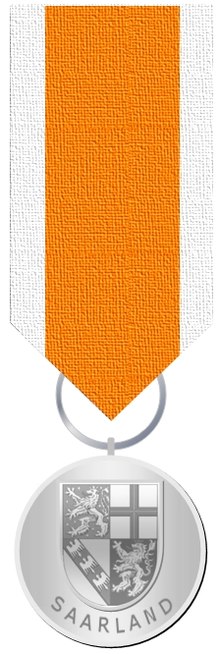Saarland Rescue Medal
The Saarland Rescue Medal is a state recognition of the federal state of Saarland for people who have carried out rescue operations at the risk of their own lives. The rescue medal was donated on November 24, 1959 by the Saarland state parliament, represented by the then Prime Minister Franz-Josef Röder and the then Minister of the Interior Kurt Conrad .
Content of the law
Award requirements
The Rescue Medal is only awarded to those people who, at the risk of their own lives, have averted either people from mortal danger or a significant danger to life and health threatening the general public. You must have shown a special measure of courage and willingness to make sacrifices in this rescue act. The award can only take place once to one and the same person, whereby the award is expressly permitted posthumously. If the rescue act was unsuccessful despite considerable efforts by the rescuer or if the rescuer was in possession of the rescue medal before this act, a public commendation is given. In addition to the public commendation and the rescue medal, a cash reward can also be granted. Another requirement for being awarded the Rescue Medal is that the rescuer is worthy of state recognition. However, people who are professionally entrusted with protecting the lives of others will only receive the rescue medal if they have significantly exceeded their duties during the rescue act . A German citizenship of the rescuer is not a requirement for the award, i. That is, the Rescue Medal can also be awarded to foreign residents. The rescue medal can also be withdrawn again if the rescuer appears unworthy of the award due to his later behavior, in particular due to criminal offenses, or if such has subsequently become known. In all cases of the award of the medal as well as of the public commendation and the monetary reward, the Minister of the Interior decides on behalf of the state government. In all cases, a certificate is issued and the file is published in the Saarland official gazette. The rescue medal becomes the property of the borrowed person; in the case of posthumous award, the award is made to the bereaved. It was expressly regulated that rescue acts from the period from May 8, 1945 to the entry into force of this law (November 24, 1959) are retrospectively recognized, even if state recognition has already been granted. However, only on request and not ex officio.
Appearance and texture
The rescue medal is made of silver and has a diameter of 25 mm and shows on its front the embossed Saarland coat of arms with the inscription: SAARLAND . The reverse shows a closed oak wreath with the central inscription: For rescue from danger It is worn on a 28 mm wide orange-white ribbon on the left side of the chest.
Implementing regulation
The ordinance, which was also issued on the same day, then regulates the more precise procedure for the award and the preparatory work of the authorities. The rescue medal is only given by the Minister of the Interior and the public commendation and / or monetary reward
- a) to persons in the public service by the head of the authority,
- b) to other persons by the head of the lower administrative authority
- c) to pupils by the school principal.
The municipalities in whose area the rescue act was carried out are responsible for determining the rescue acts. The investigation must be accompanied by a report, which is forwarded to the Minister of the Interior, which must contain precise information about the persons and the course of the crime:
Exception rules
The rescue medal can only be awarded to people who are worthy of this award. However, the implementation regulations allow exceptions in two cases, which, however, may not necessarily lead to the award of the medal:
- if the rescuer does not have the civil rights at the time of the rescue act, it must be checked whether a pardon appears appropriate due to the rescue act, or
- if there are concerns about state recognition because of other criminal convictions of the rescuer, the decision is based on the situation of the individual case.
See also
Individual evidence
- ↑ Act No. 697 on the state recognition of rescue acts of November 24, 1959, Section 1
- ↑ Act No. 697 on the State Recognition of Rescue Acts of November 24, 1959, Section 3 (1)
- ↑ Act No. 697 on the State Recognition of Rescue Acts of November 24, 1959, Section 3, Paragraphs 2 and 3
- ↑ Act No. 697 on the state recognition of rescue acts of November 24, 1959 §4 and 5 paragraph 1
- ↑ Ordinance on the implementation of the Act on State Recognition for Rescue Acts, Section 1
- ↑ Act No. 697 on the state recognition of rescue acts of November 24, 1959, Section 6
- ↑ Act No. 697 on the state recognition of rescue acts of November 24, 1959, Section 8
- ↑ Act No. 697 on the State Recognition of Rescue Acts of November 24, 1959, Section 2 (1)
- ↑ Act No. 697 on the State Recognition of Rescue Acts of November 24, 1959, Section 2 (2)
- ↑ Ordinance on the implementation of the Act on State Recognition of Rescue Acts, Section 4
- ↑ Ordinance on the implementation of the Act on State Recognition of Rescue Acts, Section 6
